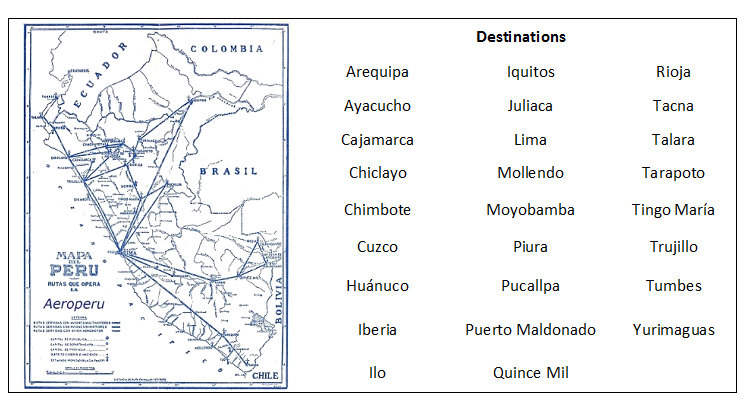Empresa Nacional de Transporte Aéreo del Perú
The
Empresa Nacional de Transporte Aéreo del Perú, operating under the name
Aeroperú, is the national flag carrier of Perú, operating international and domestic routes as well as providing local transport services in the rural district of the Amazon basin and the Altiplano. It came into being on 15 September 1945 through the amalgamation of the quasi-military
Servicio Aéreo de Transporte Comercial with the formerly private
Compañía de Aviación Faucett, and the
Compañía de Aviación Peruanas, the local subsidiary of Pan American Grace Airways.
Route System
The airline presently serves twenty-six destinations across the country on a scheduled basis, operating to all parts of the nation. In addition to scheduled passenger and cargo services
Aeroperú operates a fleet of small aircraft to undertake charters and emergency flights in isolated regions of the Amazon and the Altiplano.
 Equipment
Aeroperú
Equipment
Aeroperú operates a variety of aircraft to provide efficient services to the varied regions of the nation. A trio of American-built DC-4 four-engine aircraft are operated on high density services, while American-sourced Douglas DC-3, Lockheed 18 Lodestar, and Lockheed Model 14 Electra twin-engine aircraft are employed on medium-density routes. The workhorse of the local and rural network is the indigenous ENA C-19 Pardusco, of which more than thirty examples have entered service since its introduction.
Orders were recently placed in the Netherlands for five Fokker F.26 twin-engine airliners which will permit retirement of some of the Douglas/Lockheed fleet upon their delivery. Also acquired were three civil versions of the Fokker F.39 heavy transport, which will operate special freight services to the Amazon basin while executing freight charters.

